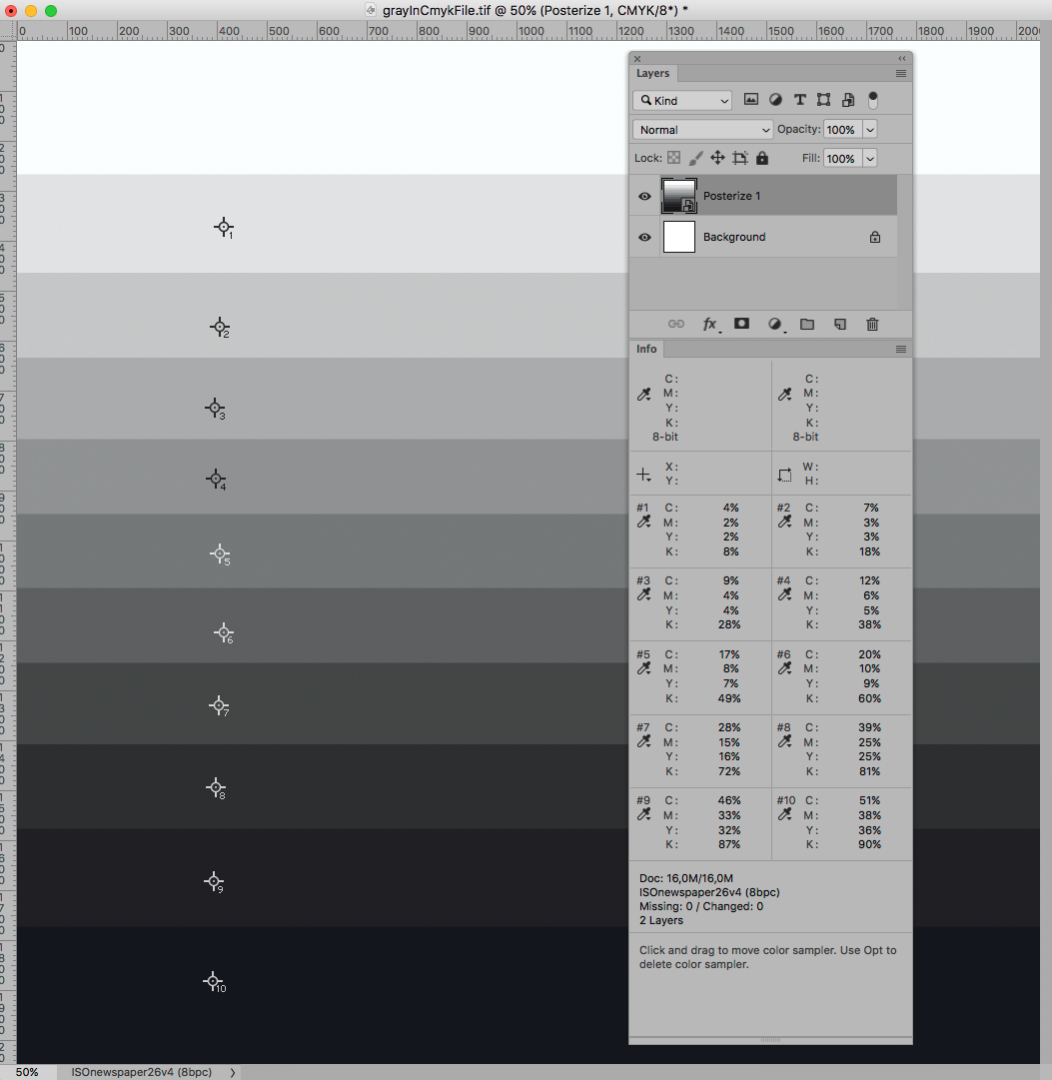 Adobe Community
Adobe Community
- Home
- Photoshop ecosystem
- Discussions
- Re: Adjustment layers not working in CMYK MODE?
- Re: Adjustment layers not working in CMYK MODE?
Adjustment layers not working in CMYK MODE?
Copy link to clipboard
Copied
Hi Guys
I have a photoshop issue and was wondering if you could shed any light on the matter?
When ever i set my document to CMYK mode, some of my adjustment layers become 'un-selectable' such as the Black & White, vibrance and the exposure adjustment layers?
They work fine in RGB mode but was curious if this was common place?
Any information woould be greatful
Explore related tutorials & articles
Copy link to clipboard
Copied
Indeed not all adjustments are available in modes other than RGB.
Have you read »Correcting colors in CMYK and RGB« in the Help yet?
Working in CMYK should be a very deliberate decision – why do you want to work on CMYK images?
Copy link to clipboard
Copied
No i have not read the »Correcting colors in CMYK and RGB« how do i go about finding that particular thread?
I am working in cmyk as the poster i am producing is for print, so the document is put into that mode for that purpose.
I am aware that some of the adjustments woyl not work in all different modes but surely the black and white one does? or am i wrong there?
Copy link to clipboard
Copied
but surely the black and white one does? or am i wrong there?
It would seem you are.
You can still use Hue/Saturation as a work-around.
how do i go about finding that particular thread?
That’s no thread but a headline in the Help; personally I prefer to download the pdf:
http://help.adobe.com/en_US/photoshop/cs/using/index.html
I am working in cmyk as the poster i am producing is for print, so the document is put into that mode for that purpose.
If you are using/combining photographic images this approach may not be ideal and incurs the risk of overshooting the TAC.
On the other hand if you have lots of text, fine lines or other elements that are supposed to, for example, print in pure black working in CMYK would be called for.
Copy link to clipboard
Copied
Well, you see, in printing CMYK is standard... Why shouldn't I be able to create a B&W adjustment layer in printing projects? Doesn't really make sense considering K stands for 'Black,' and 'White' is just all of the colors.
Copy link to clipboard
Copied
Desaturation in CMYK isn't straightforward and linear. Try for yourself - set up a Hue/Sat layer and pull back the saturation slider. You get a sepia-toned image. This is because the inks have different densities, and the cyan ink normally requires a higher percentage. But the exact ratio varies with different CMYK profiles. Furthermore, the ratio varies with the tone curves in each ink.
Every CMYK profile is based on real physical ink hitting real physical paper. It's not a "theoretical" color space with regular behavior.
Copy link to clipboard
Copied
considering K stands for 'Black,'
The »K« derives from »Key«.
Why shouldn't I be able to create a B&W adjustment layer in printing projects?
To create the proper grays for a CMYK space the Adjustment would have to take into account at the very least the CMYK space’s TAC and GCR (or UCR).
And as far as I can tell that would complicate calculation considerably.
Copy link to clipboard
Copied
megt32681354 wrote
Well, you see, in printing CMYK is standard...
Hi Meg,
Please read this from InDesign Secrets. It was written five years ago, so where David and Claudia say they’ve been saying this for fifteen years, it has now been twenty:
https://indesignsecrets.com/import-rgb-images-indesign-convert-cmyk-export.php
~ Jane
Copy link to clipboard
Copied
And just to give an example of how dependent a proper CMYK-gray is on the Color Space two screenshots of the same neutral Lab-SO in two CMYK spaces with Color Samplers (the CMYK Spaces are indicated in the Status Bar bottom left).


Copy link to clipboard
Copied
Well, you see, in printing CMYK is standard...
It is a destination print color space, but it is problematic as an editing space.
There's no reason why you can’t edit in a large gamut RGB space like AdobeRGB or ProPhoto RGB, and make the conversion to CMYK later in the workflow, either during the export from page layout or in the print RIP when it is more likely that the destination profile will be known. See jane-e's link
There are also a number of problems with editing in CMYK.
Most offset CMYK press profiles have a total ink limit and if you exceed that limit the sheet might not dry properly. The ink limit is enforced on the conversion from RGB to CMYK. Once you are in CMYK mode it would be possible to exceed the limit (i.e., inverting white pixels, multiplying two dark color values, etc).
The proper gray balance and black ink generation is also built into the destination CMYK profile, and would be correct on the initial conversion to CMYK, but could easily be ruined with subsequent color corrections.
And finally if you are going to edit in CMYK you have to be sure of the final destination profile. If you were to edit a document with the US Web SWOP Coated assigned, and later the image needed to be output to GRACol Coated; there would have to be either a CMYK-to-CMYK conversion, or a conversion back to RGB or Lab, followed by a conversion to the new CMYK space. In either case your original CMYK values would be gone.
Copy link to clipboard
Copied
Here's the TAC problem that c.pfaffenbichler and I pointed out. The SWOP ink limit is 300%:

Copy link to clipboard
Copied
Another thing:
»The separate Photoshop Windows and Macintosh forums will become Read Only on Tuesday, January 3rd.«
So don’t be surprised if this thread should lock up on you tomorrow.
Copy link to clipboard
Copied
I had this same issue, and found this forum, the given advice didn't help much in my case, but what I found that did help is color grading in the "chanel mixer" adjustment layer.
I'm editing portraits for print, using gel lighting, my web copies are awesome, print copies gave me trouble, editing in CMYK just to make sure that what I'm editing is an acurate image.
This is the closest adjustment to exposure you can get in CMYK since exposure is diabled. Just color correct more in "hue & saturation" if this changes your colors too much.
Copy link to clipboard
Copied
@Juliet_Hunt How did you pick your CMYK space? Unless you have been given a specific CMYK profile to use by your printer (i.e. the guy who runs your press) then you are making a mistake. There is no generic CMYK. You should not be converting to CMYK until you know exactly which CMYK profile will be used at the print stage.
If your prints will be output on an inkjet printer either at home on in a printing shop, then stay in RGB. The conversion from RGB to the CMYK+other inks (for example mine uses C,M,Y,K,LK,LLK,LC,LM,O,G) will be done by the inkjets print driver which is expecting RGB input. By working in a CMYK space prior to that I would be restricting my use of the additional ink colours.
Dave





